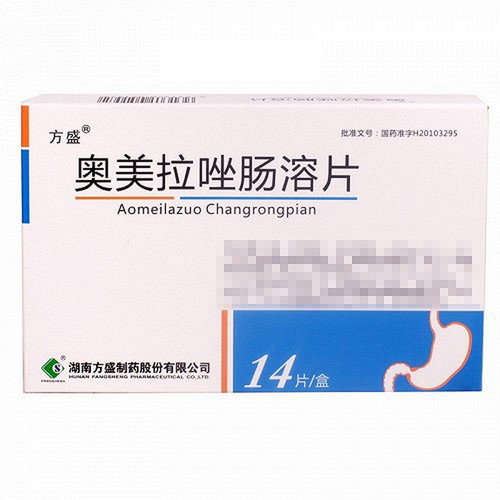Product Overview
[Drug Name]
Trade Name: Omeprazole Magnesium Enteric-Coated Tablets
Chinese Pinyin: Aomeilazuomei Changrong Pian
[Ingredients]
The main ingredient of this product is omeprazole magnesium.
[Properties]
This product is an enteric-coated film-coated tablet. After removing the coating, it appears off-white or light yellow.
[Indications]
Duodenal ulcer, gastric ulcer, reflux esophagitis, Zollinger-Ellison syndrome.
[Dosage and Administration]
The tablet must be swallowed whole with at least half a cup of liquid. Do not chew or crush the tablet. Disperse it in water or a slightly acidic liquid (such as juice). The dispersion must be consumed within 30 minutes. Duodenal ulcer: The normal dose is 20 mg of this product once daily. The ulcer usually heals within two weeks.
[Adverse Reactions]
Clinical trials have shown that the most common adverse reactions are headaches and gastrointestinal symptoms such as diarrhea, nausea, and constipation (constipation is a symptom of various conditions, not a disease itself. Common symptoms include a significant decrease in bowel movements, with irregular bowel movements every 2-3 days or longer, and hard, dry stool. Long-term constipation can affect the functioning of the spleen and stomach, leading to abnormal bowel movements and the accumulation of toxins, which can lead to gastrointestinal discomfort, bad breath, and dark spots. Traditional Chinese Medicine believes that constipation is often caused by internal heat and qi stagnation, which should be eliminated through expelling heat and dissolving stagnation. Therefore, eliminating constipation requires fundamental conditioning of the body and should not be rushed with medications that are highly irritating to the gastrointestinal tract.). The incidence rate is 1-3%.
[Contraindications]
Losec is contraindicated in patients allergic to Losec.
[Precautions]
1. Do not use for more than 7 days. If symptoms persist, consult a physician or pharmacist. 2. Do not use again within 2 months. If symptoms recur, seek medical attention immediately. 3. Do not use this product if: swallowing is difficult or painful; vomiting blood; or if you have bloody or black stools. These may be signs of a serious condition; consult a physician. 4. Patients with liver dysfunction or abnormal blood counts should use this product under the guidance of a physician. 5. If heartburn persists or worsens, discontinue use and seek medical attention. 6. Children should only use this product under the guidance of a physician. 7. Use with caution during pregnancy and lactation. 8. In case of overdose or serious adverse reactions, seek medical attention immediately. 9. Contraindicated for those allergic to this product. Use with caution if allergic. 10. Do not use if the properties of this product change. 11. Keep this product out of reach of children. 12. Children must be supervised by an adult before use. 13. If you are using other medications, consult a physician or pharmacist before using this product.
[Use in Special Populations]
Precautions for use in children: There is limited experience with this product in children.
Precautions for pregnancy and lactation: Use with caution during pregnancy and lactation.
Elderly Precautions: No dosage adjustment is required for this drug in the elderly, but clearance is decreased in elderly patients.
[Drug Interactions]
1. Due to its effect on gastric pH, this drug may affect the absorption of other drugs. Therefore, the absorption of ketoconazole and itraconazole may be decreased during treatment with omeprazole or other acid inhibitors or antacids. 2. This drug is metabolized in the liver by the CYP2C19 enzyme and may increase the plasma concentrations of other drugs metabolized by this enzyme, such as diazepam, phenytoin, and warfarin (R-warfarin, low activity). Patients currently receiving phenytoin, warfarin, or other vitamin K antagonists should be monitored when initiating or discontinuing omeprazole. 3. This drug (40 mg daily) increases the Cmax and AUC of voriconazole (a CYP2C19 substrate) by 15% and 41%, respectively. Voriconazole increases the AUCt of omeprazole by 280%. Omeprazole dosage adjustment should be considered in patients with severe hepatic impairment during combined use and long-term treatment. 4. Omeprazole plasma concentrations may increase when this product is co-administered with clarithromycin or erythromycin. However, there is no interaction with metronidazole or amoxicillin. 5. Co-administration of this product with drugs that inhibit CYP2C19 or CYP3A4 (HIV protease inhibitors, ketoconazole, itraconazole) may increase omeprazole plasma concentrations. 6. Studies have shown that a daily oral dose of 20-40 mg of this product does not affect other related CYP isoenzymes and has no metabolic interactions with the following substrates: CYP1A2 (caffeine, phenacetin, theophylline), CYP2C9 (S-warfarin, piroxicam, diclofenac, and naproxen), CYP2D6 (metoprolol, propranolol), CYP2E1 (ethanol), and CYP3A (cyclosporine, lidocaine, quinidine, estradiol, erythromycin, and budesonide). 7. Proton pump inhibitors, including omeprazole, should not be coadministered with atazanavir. Coadministration of omeprazole (40 mg once daily) with atazanavir 300 mg/ritonavir 100 mg reduced atazanavir exposure in healthy subjects (AUC, Cmax, and Cmin decreased by approximately 75%). Increasing the atazanavir dose to 400 mg did not compensate for the effect of omeprazole on atazanavir exposure. 8. Coadministration of omeprazole with tacrolimus may increase the serum concentration of tacrolimus. Monitoring tacrolimus plasma concentrations is recommended when coadministration and discontinuation of omeprazole.
[Pharmacological Action]
Omeprazole is a substituted benzimidazole compound that is a racemate of a pair of active optical enantiomers. Omeprazole acts on the proton pump in parietal cells through a specific mechanism, reducing gastric acid secretion; this effect is reversible. Omeprazole is a weak base that is concentrated and converted to its active form in the acidic environment of parietal cells. It inhibits the H+/K+-ATPase enzyme, the final step in hydrochloric acid production in gastric juice. This inhibitory effect is dose-dependent and affects both basal and stimulated gastric acid secretion, regardless of the type of stimulus. Omeprazole has no effect on cholinergic and histamine receptors. Similar to H2 receptor blockers, omeprazole reduces gastric acidity, leading to a reversible increase in gastrin levels proportional to the decrease in acidity. There have been reports of an increased incidence of gastric glandular cysts with long-term treatment. These changes are physiological consequences of suppressed gastric acid secretion and are benign and reversible. The reduction in gastric acid caused by proton pump inhibitors or other acid suppressants can increase the number of normal bacteria in the gastrointestinal tract, leading to a slight increase in the risk of gastrointestinal infections (such as Salmonella and Campylobacter) with treatment. Aside from its effects on gastric acid secretion, no other clinically significant pharmacodynamic effects of omeprazole have been observed. The effect on gastric acid secretion is directly related to the area under the plasma concentration-time curve (AUC), but is unrelated to the actual plasma concentration at a given time. A 20 mg oral dose of this drug reduces gastric acid secretion within 2 hours. Maximum effect is achieved with once-daily dosing for three to five days. In patients with duodenal ulcers, 24-hour gastric acidity is reduced by an average of approximately 80%, and pentagastrin-stimulated gastric acid production is reduced by approximately 70% 24 hours after dosing. Omeprazole's inhibitory effect on gastric acid secretion persists for a long time, with gastric acid secretion returning to normal five days after discontinuation of medication. One 20 mg tablet daily provides symptom relief within the first day and cures most duodenal ulcers within two weeks, while cure may take four weeks for patients with gastric ulcers and reflux esophagitis. Omeprazole may enhance the antibacterial activity of some antibiotics against Helicobacter pylori.
[Storage]
Store tightly closed below 25°C.
[Strength]
10mg
[Packaging]
10mg x 14s/box
[Shelf Life]
18 months
[Approval Number]
National Medicine Standard H20067766
[Manufacturer]
Company Name: Xuchang High-Tech Pharmaceutical Co., Ltd.






